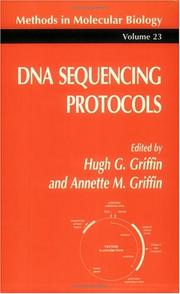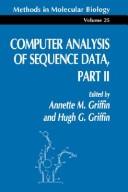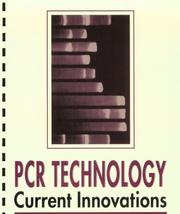| Listing 1 - 4 of 4 |
Sort by
|

ISBN: 0896032485 1592595103 1489939962 Year: 1993 Volume: 23 Publisher: Totowa, NJ : Humana Press : Imprint: Humana,
Abstract | Keywords | Export | Availability | Bookmark
 Loading...
Loading...Choose an application
- Reference Manager
- EndNote
- RefWorks (Direct export to RefWorks)
The purpose of DNA Sequencing Protocols is to provide detailed practical procedures for the widest range of DNA sequencing meth ods, and we believe that all the vanguard techniques now being applied in this fast-evolving field are comprehensively covered. Sequencing technology has advanced at a phenomenal rate since the original methods were first described in the late 1970s and there is now a huge variety of strategies and methods that can be employed to determine the sequence of any DNA of interest. More recently, a large number of new and innovative sequencing techniques have been developed, including the use of such novel polymerases as Tag poly merase and Sequenase, the harnessing of PCR technology for linear amplification (cycle) sequencing, and the advent of automated DNA sequencers. DNA sequencing is surely one of the most important techniques in the molecular biology laboratory. Sequence analysis is providing an increasingly useful approach to the characterization of biological systems, and major multinational projects are already underway to map and sequence the entire genome of organisms, such as Escherichia coli, Saccharomyces cerevisiae, Caenorhabditis elegans, and Homo sapiens. Most scientists recognize the importance of DNA sequence data and perceive DNA sequencing as a valuable and indispensable aspect of their work. Recent technological advances, especially in the area of automated sequencing, have removed much of the drudg ery that was formerly associated with the technique, whereas innova tive computer software has greatly simplified the analysis and manipulation of sequence data.
Sequence Analysis, DNA --- Nucleotide sequence --- Séquence nucléotidique --- Nucleotide sequence. --- Sequence Analysis --- Genetic Techniques --- Investigative Techniques --- Analytical, Diagnostic and Therapeutic Techniques and Equipment --- Animal Biochemistry --- Human Anatomy & Physiology --- Health & Biological Sciences --- Sequence Analysis, DNA. --- 57.088.5 --- 577.212.3 --- Methods and techniques for studying structures and properties of biological molecules --- Nucleic acid base and sequence compositon. Experimental deciphering of genetic code. --- 577.212.3 Nucleic acid base and sequence compositon. Experimental deciphering of genetic code. --- Sequence analysis, dna. --- Séquence nucléotidique --- Analysis, Nucleic acid sequence --- Analysis, Nucleotide sequence --- Base sequence (Nucleic acids) --- DNA sequence --- Nucleic acid sequence analysis --- Nucleotide sequence analysis --- RNA sequence --- Sequence, Nucleotide --- Nucleic acids --- Nucleotides --- Sequence alignment (Bioinformatics) --- Nucleic acid base and sequence compositon. Experimental deciphering of genetic code --- Analysis --- Life sciences. --- Cell biology. --- Life Sciences. --- Cell Biology. --- Cell biology --- Cellular biology --- Biology --- Cells --- Cytologists --- Biosciences --- Sciences, Life --- Science --- Cytology.

ISBN: 0896032469 0896032760 159259512X 1592595111 Year: 1994 Volume: 24, 25 Publisher: Totowa, NJ : Humana Press : Imprint: Humana,
Abstract | Keywords | Export | Availability | Bookmark
 Loading...
Loading...Choose an application
- Reference Manager
- EndNote
- RefWorks (Direct export to RefWorks)
DNA sequencing has become increasingly efficient over the years, resulting in an enormous increase in the amount of data gener ated. In recent years, the focus of sequencing has shifted, from being the endpoint of a project, to being a starting point. This is especially true for such major initiatives as the human genome project, where vast tracts of DNA of unknown function are sequenced. This sheer volume of available data makes advanced computer methods essen tial to analysis, and a familiarity with computers and sequence analy sis software a vital requirement for the researcher involved with DNA sequencing. Even for nonsequencers, a familiarity with sequence analysis software can be important. For instance, gene sequences already present in the databases can be extremely useful in the design of cloning and genetic manipulation experiments. This two-part work on Computer Analysis of Sequence Data is designed to be a practical aid to the researcher who uses computers for the acquisition, storage, or analysis of nucleic acid (and/or pro tein) sequences. Each chapter is written such that a competent scien tist with basic computer literacy can carry out the procedure successfully at the first attempt by simply following the detailed prac tical instructions that have been described by the author. A Notes section, which is included at the end of each chapter, provides advice on overcoming the common problems and pitfalls sometimes encoun tered by users of the sequence analysis software.
Amino acid sequence --- Nucleotide sequence --- Data processing. --- 577.212.3 --- 57.088.5 --- 57.081.2 --- 57.081.2 Automation of biological experiments --- Automation of biological experiments --- 577.212.3 Nucleic acid base and sequence compositon. Experimental deciphering of genetic code. --- Nucleic acid base and sequence compositon. Experimental deciphering of genetic code. --- Methods and techniques for studying structures and properties of biological molecules --- Séquence des acides aminés --- Séquence nucléotidique --- Data processing --- Informatique --- Amino acid sequence analysis --- Analysis, Amino acid sequence --- Peptide sequence --- Peptide sequencing --- Protein sequence --- Protein sequencing --- Sequence, Amino acid --- Amino acids --- Proteins --- Sequence alignment (Bioinformatics) --- Analysis --- Cytology. --- Cell Biology. --- Cell biology --- Cellular biology --- Biology --- Cells --- Cytologists

ISBN: 0849386748 9780849386749 Year: 1994 Publisher: Boca Raton (Fla.): CRC,
Abstract | Keywords | Export | Availability | Bookmark
 Loading...
Loading...Choose an application
- Reference Manager
- EndNote
- RefWorks (Direct export to RefWorks)
Book
ISBN: 189848600X Year: 1993 Publisher: Wymondham Horizon scientific press
Abstract | Keywords | Export | Availability | Bookmark
 Loading...
Loading...Choose an application
- Reference Manager
- EndNote
- RefWorks (Direct export to RefWorks)
| Listing 1 - 4 of 4 |
Sort by
|

 Search
Search Feedback
Feedback About UniCat
About UniCat  Help
Help News
News